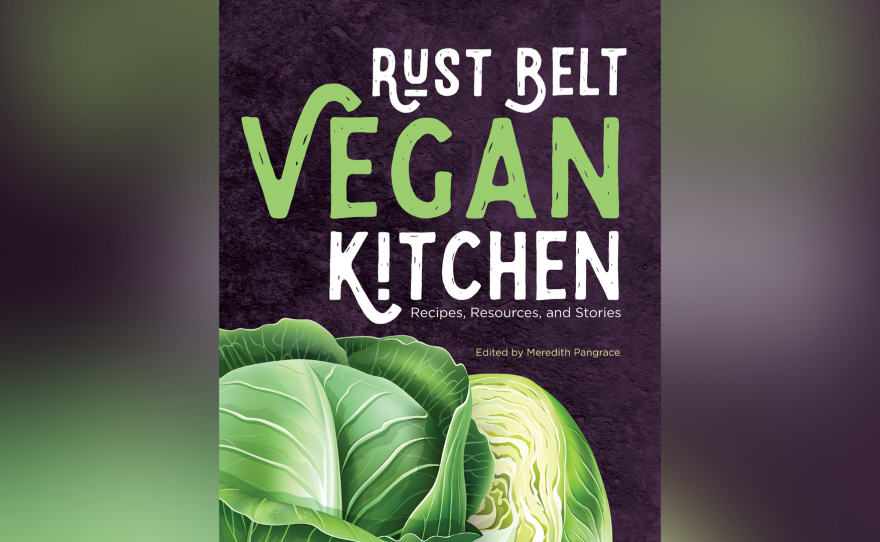What defines Midwestern food is debatable, but most would agree: it’s not famous for being plant-centric.
Coney dogs.
Deep-dish pizza.
Whitefish dip.
Pasties.
Shawarma, pierogi, pazcki… the list is long, and most of it involves meat, eggs, milk, or cheese to make.
But Meredith Pangrace said she believed that it had the potential to be re-envisioned. So she turned to social media to collect vegan recipes from home cooks and professional chefs across the region, seeking the best vegan versions of Midwestern classics and working to define the cuisine itself in the process.
“When I was working on the section about the plant-based meats and talking about Polish boys and coney dogs and the whole hot dog situation, I had a Sunday weenie roast,” Pangrace said of her vegan hot dog and sausage testing. “We got into a pretty heated debate about what even determines a Cleveland Polish boy. So what the toppings are in the peppers preparation, and how does that differ from the Detroit style coney dog?”
The debate spurred the new cookbook Rust Belt Vegan Kitchen, which looks to move the needle on diverse, plant-based, distinctively Midwestern cooking. It includes vegan versions of southern recipes brought north during the Great Migration, like mac and cheese, and dumplings and gravy. It represents dishes brought to the Midwest by Eastern European immigrants, like matzo ball soup. And it includes dishes from a range of global origins within its definition of Midwestern, with recipes like West African Peanut Stew and Mole de Xico on Roasted Chayotes.
In editing the collection of recipes, Pangrace said she wanted to build a resource that blended accessibility and variety in its selection of tasty vegan adaptations. And she said it was important to her to structure the book and to select recipes “so that [the] book wouldn’t be as intimidating for people that are new to this.”
What does an accessible Midwestern vegan cookbook look like?
It includes a range of simple and complex recipes, suitable for seasoned vegan chefs and folks newly curious about making plant-based food. There are options for quick weeknight dinners or elaborate holiday meals. And it starts with a ground-zero discussion of staple ingredients, both ready-made and make-it-yourself.
Many of the homemade substitutions for ingredients like eggs are simple and versatile, like mixing flax seeds and tap water or saving the liquid from a can of chickpeas/garbanzo beans. That starchy liquid, called aquafaba, can turn into anything from a fluffy meringue to a silky, savory Midwestern-must: mayonnaise.
“If you emulsify [the aquafaba] with a hand blender like a stick blender—I find works best, or a regular blender with oil and spices—you actually can make an amazing, amazing, homemade mayo. And I've tried a lot of different homemade mayos. I've tried ones with tofu that were, you know, passable but not great. But the aquafaba mayo, and we include the recipe in the book, is really fantastic. Like, I always now have a jar of it in my fridge.
Pangrace emphasized you don’t have to DIY everything, though.
“We're not being pretentious. We're not saying like, you have to go out and, you know, make everything from scratch and be like, there are convenience foods that are accidentally vegan that can kind of help make this easier for you.”
The book offers specific vegan product suggestions, both nationally available and regionally made. Pangrace said it’s worth giving store-bought vegan options a try even if you’ve had a hard time finding them in the past. She noted that many have gotten tastier as well as easier to find in recent years.
“Now that plant-based eating is becoming more popular, you can find some of these already made substitutions in your local grocery stores,” Pangrace said. “For example, finding vegan cream cheese and vegan cheese and vegan sausages isn't as hard as it used to be. So we do cover some of the store brands that you can buy and make some suggestions. We also cover some Midwest businesses that are making some of those things here in the Midwest.”
The book also highlights what Pangrace called “secretly vegan” foods you might already be eating and buying. Pillsbury Crescent Roll dough is the secret to the normally sour cream or cream cheese based kolache cookies in this book, for example.
Pangrace said she wanted to share the stories behind the vegan adaptations, and asked cooks “Why are you doing this?” when they submitted their recipes for consideration. “Everybody had different reasons,” she said.
Some people took the challenge of working with new ingredients or perfecting a favorite recipe with a radically different technique. For others, health motivations or attention to environmental impact motivated them to adapt a meaty or cheesy classic into an equally satisfying alternative. For still others, religious beliefs played a role. Or, a combination of factors pointed them toward veganism or toward occasional vegan cooking.
“The book is not preachy,” Pangrace said. “We're not really kind of telling you that you should. We're just saying, here are some people. Here's why they're doing it. Listen to their stories and open your mind to it and try it.”










